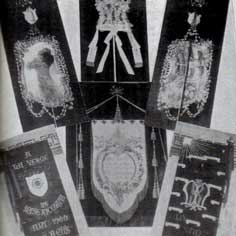The Pity banner (1900)
 On Sunday the 22nd April of 1900, Anton Gaudí participated in the pilgrimage in the sanctuary of the Virgin of Pity, pattern of Reus, on the occasion of the change of century.
In the great procession for the streets of Reus, each group paraded with his banner. Gaudí made the banner of the group of the natural from Reus inhabitants of Barcelona, that they were some two hundred.
Of the forty-nine banners, three were given to Our Lady and remained in the sanctuary, among them that of Gaudí. In the picture published by the "Semanario Católico de Reus" on the 21st of July of 1900, the obverse and the verso the ones are placed in the upper part.
It was a pennon splendid, very superior to the other ones. It was from drilled and reprised leather. In the part of the front, the painter Aleix Clapés had painted Isabel Besora -weary shepherd of the 16th century to who the Virgin of Pity appeared- of natural size, in beseeching attitude. The part of the last filled in a big shield of Barcelona of golden and silvery leather about deep of very rich y tissue of gold damask. In the center, the rose of Reus with its five leaves made of repoussé and sheared platinum. About the purely said pennon, there was a little statue of the Virgin of Pity, of aluminum, replayed by the system said on lost wax, very well colored. Two little angels also of aluminum hold the widespread mantle. Above the Virgin, the Very Holy Name of Jesus; and more up, the Cross, dominating everything, like in each work of Gaudí. In the high part of the pennon, in front as well as behind, it campaigned the inscription MISERICÒRDIA, with letters of repoussé and sehared aluminum and decorated with a very rich variegation. In the low part of the pennon, in front, "Pe'l segle XIX", and behind, "Per nantrus". In a side and in another, framing the pennon, "Barcelona" and "Reus". As a whole, it was dazzling, an authentically gaudinian jewel, for the beauty, the price, the symbolism and the organic unit of the diversity of materials and elements. It joined all of them surrounding the pennon, precisely a giant rosary fulfilled, of aluminum and bronze.
The pennon behaved with a very rich cane of bamboo with applications of metal.
This mass act did not have any folkloric, political, traditionalistic or cultural purpose, but was "in a pure way and exclusively a demonstration of Catholic faith, without any other mobile object than the glory of God and of the saintliest Virgin".
The "Semanario Católico de Reus" published the picture of this group. It was the second time that the image of Gaudí turned up in the press; he, for personal modesty, refused to be portrayed, and the journalists learned soon that the only possibility was to use his step in the processions.
On Sunday the 22nd April of 1900, Anton Gaudí participated in the pilgrimage in the sanctuary of the Virgin of Pity, pattern of Reus, on the occasion of the change of century.
In the great procession for the streets of Reus, each group paraded with his banner. Gaudí made the banner of the group of the natural from Reus inhabitants of Barcelona, that they were some two hundred.
Of the forty-nine banners, three were given to Our Lady and remained in the sanctuary, among them that of Gaudí. In the picture published by the "Semanario Católico de Reus" on the 21st of July of 1900, the obverse and the verso the ones are placed in the upper part.
It was a pennon splendid, very superior to the other ones. It was from drilled and reprised leather. In the part of the front, the painter Aleix Clapés had painted Isabel Besora -weary shepherd of the 16th century to who the Virgin of Pity appeared- of natural size, in beseeching attitude. The part of the last filled in a big shield of Barcelona of golden and silvery leather about deep of very rich y tissue of gold damask. In the center, the rose of Reus with its five leaves made of repoussé and sheared platinum. About the purely said pennon, there was a little statue of the Virgin of Pity, of aluminum, replayed by the system said on lost wax, very well colored. Two little angels also of aluminum hold the widespread mantle. Above the Virgin, the Very Holy Name of Jesus; and more up, the Cross, dominating everything, like in each work of Gaudí. In the high part of the pennon, in front as well as behind, it campaigned the inscription MISERICÒRDIA, with letters of repoussé and sehared aluminum and decorated with a very rich variegation. In the low part of the pennon, in front, "Pe'l segle XIX", and behind, "Per nantrus". In a side and in another, framing the pennon, "Barcelona" and "Reus". As a whole, it was dazzling, an authentically gaudinian jewel, for the beauty, the price, the symbolism and the organic unit of the diversity of materials and elements. It joined all of them surrounding the pennon, precisely a giant rosary fulfilled, of aluminum and bronze.
The pennon behaved with a very rich cane of bamboo with applications of metal.
This mass act did not have any folkloric, political, traditionalistic or cultural purpose, but was "in a pure way and exclusively a demonstration of Catholic faith, without any other mobile object than the glory of God and of the saintliest Virgin".
The "Semanario Católico de Reus" published the picture of this group. It was the second time that the image of Gaudí turned up in the press; he, for personal modesty, refused to be portrayed, and the journalists learned soon that the only possibility was to use his step in the processions.
All rights reserved
Last update: 06/05/2016